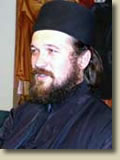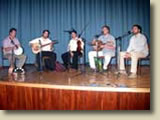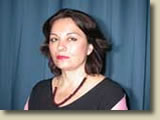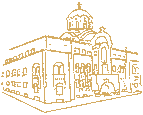| Information
Service of
the Serbian Orthodox Church
July 2, 2004

POPE ACCEPTS ECUMENICAL PATRIARCH’S INVITATION
TO VISIT CONSTANTINOPLE
After his four-day official visit to the Vatican, His All-Holiness
Patriarch Bartholomew of Constantinople invited His Holiness
Pope John Paul II to visit the see of the Ecumenical Patriarchate
in Constantinople. Pope John Paul II was pleased to accept the
invitation.
Earlier, the two religious leaders signed a joint
declaration in which they reaffirm their commitment to work
toward the full
unity of Christians in order to proclaim the Gospel in a "more
credible and convincing" way. They also relaunched the work
of the International Mixed Commission for Theological Dialogue
between the Catholic Church and the Orthodox Church.
On July 1 the Patriarch of Constantinople served
Holy Hierarchal Liturgy in the Church of St. Theodore on the
Palatine with the
concelebration of Metropolitan Gennadios of Italy. In his sermon
His All-Holiness emphasized that on the path toward full unity
between Catholics and Orthodox "still have a long way to
go. Let us go forward despite so many difficulties through the
dialogue of charity and truth." Cardinal Walter Kasper,
president of the Pontifical Council for Promoting Christian Unity;
Cardinal Camillo Ruini, the Pope's vicar for Rome; and Archbishop
Leonardo Sandri, substitute for general affairs of the Vatican
Secretariat of State attended Holy Liturgy.
Source: www.zenit.org 
METROPOLITAN KIRILL OF SMOLENSK AND KALININGRAD VISITS THE NETHERLANDS
His Eminence Metropolitan Kirill of Smolensk and Kaliningrad,
Chairman of the Department for External Church Relations of the
Moscow Patriarchate, was on a visit to the Netherlands from June
18 to 21, 2004. Metropolitan Kirill arrived to Amsterdam from
Oslo on June 18. The next day, on June 19, Metropolitan Kirill
celebrated the All-Night Vigil in the St. Nicholas Church in
Amsterdam. On June 20, the Russian Orthodox Church dedicated
to the Holy and Right-Believing Prince Alexander Nevsky (the
Hague and the Netherlands diocese of the Moscow Patriarchate)
was consecrated in Rotterdam, which is the second in size city
of the Kingdom of the Netherlands and the largest port of Europe.
Metropolitan Kirill cordially congratulated all those gathered
for the consecration of the church and thanked all people who
took part in its construction and decoration. He expressed his
gratitude to the city authorities of Rotterdam in the person
of the Mayor for their invariable attention to the needs and
interests of the Russian Orthodox parishioners and for support
with the construction of the church.
Source: www.orthodoxeurope.org (Europaica) 
CHIROTONIA OF BISHOP JOVAN  His Holiness Serbian Patriarch Pavle will officiate at the consecration
of the newly elected Bishop Jovan of Dioclea and vicar (auxiliary)
bishop of the Metropolitanate of Montenegro and the Littoral,
Abbot of Ostrog Monastery, to be held tomorrow in the monastery
of Cetinje. On Sunday, July 4, 2004 beginning at 9:00 a.m. His
Holiness will serve Holy Hierarchal Liturgy in church of the
Resurrection of Christ in Podgorica followed by the chirotonia
of Bishop Jovan in the presence of a large number of bishops. His Holiness Serbian Patriarch Pavle will officiate at the consecration
of the newly elected Bishop Jovan of Dioclea and vicar (auxiliary)
bishop of the Metropolitanate of Montenegro and the Littoral,
Abbot of Ostrog Monastery, to be held tomorrow in the monastery
of Cetinje. On Sunday, July 4, 2004 beginning at 9:00 a.m. His
Holiness will serve Holy Hierarchal Liturgy in church of the
Resurrection of Christ in Podgorica followed by the chirotonia
of Bishop Jovan in the presence of a large number of bishops.
Abbot Jovan (Puric) of the monastery of Ostrog, was born Mladen
to Radosav and Zora nee Brankovic on June 6, 1965 in Mijaci near
Valjevo.
He completed St. Sava Seminary in Belgrade in 1985 and studied
theology in Belgrade and St. Petersburg, where he defended a
work in Byzantine studies in 1996. Prior to becoming a novice
he taught at St. Sava Seminary in Belgrade in 1990.
He was a novice in the monastery of Tronosa in 1991 and tonsured
a monk on June 17 (June 4 according to the Julian calendar used
by the Serbian Orthodox Church) 1992 in the church of the Holy
Trinity in Ostrog by Bishop Atanasije (Jevtic).
He was ordained a hierodeacon on May 18 (May 5) 1992 in the
church of the Entry of the Most Holy Mother of God into the Temple
of the Upper Monastery of Ostrog by Bishop Atanasije (Jevtic).
He was subsequently elevated to the office of hieromonk by His
Holiness Serbian Patriarch Pavle on May 14 (May 1) 1995 in the
church of the Holy Ascension of Our Lord in the monastery of
Milesevo.
He became protosyncellus in the church of the Nativity of the
Most Holy Mother of God in the monastery of Cetinje on the feast
of Bishop Amphilochius of Iconium (December 6) by His Eminence
Metropolitan Amfilohije of Montenegro and the Littoral.
He was appointed to the throne of the abbots of Ostrog on the
Elevation of the Holy Cross, January 18 (January 5) 2001 by His
Eminence Metropolitan Amfilohije.
As a professor at the St. Peter of Cetinje Seminary, he taught
on a variety of subjects (currently Orthodox dogmatics) as well
as serving as class headmaster and primary education. He is a
member of the board of directors of the Patriarchate.
On the day of the transfer of the relics of St. Sava, May 19
(May 6) 2004 he was elected as a vicar (auxiliary) bishop of
the Metropolitanate of Montenegro and the Littoral holding the
title of Bishop of Dioclea.
He has published hundreds of studies and articles. He prepared
an Anthology of Prayer Traditions based on the work of Father
Justin Popovic. He published the book “Lestvica tajnovodstvenog
putovanja” (The Ladder of Mysterious Ascent). Another book, “Ostroski
Istocnik (I deo)” (The Ostrog Source, part I) is currently in
preparation. He is also preparing the works of the Holy Fathers
in the Serbian language. He is the editor in chief and technical
editor of several books and broadcasts on Radio Svetigora. He
is one of the collaborators on the Encyclopedia of Montenegro.
He has issued a cassette and CD of his chanting.

ST VITUS DAY IN VIENNA  On the eve of Vidovdan, the congregational holiday of the entire
Serbian people, the Serbian Orthodox parish of St. Sava in Vienna
organized a formal St. Vitus Day – Vidovdan academy held in the
Haus der Begegnung Mariahilf auditorium. Participants in the
program included guests from Belgrade Protopresbyter Dr. Radovan
Bigovic, a professor at the Theological Faulty in Belgrade, who
delivered a wonderful and substantive address; National Theatre
actress Ljiljana Blagojevic; and the musical group “Beogradska
Calgija” (Belgrade Urban Instrumental Band). This group comprised
of Vladimir Nikolic, Vladimir Simic, Nikola Popmihajlov, Milan
Brkovic and Aleksandar Jovanovic impressed the many guests in
attendance, among them the Serbia and Montenegro ambassador to
Austria, Mihajlo Kovac, and his wife. Using authentic instruments
and musical traditions from the Orthodox East, these exceptionally
talented young men were highly successful in evoking the old
style of music popular among the people before the domination
of Western musical styles in our region in the second half of
the 19th century. These musically gifted young people also contributed
much to the prayers at two Liturgies in the church of St. Sava
by their chanting. On the eve of Vidovdan, the congregational holiday of the entire
Serbian people, the Serbian Orthodox parish of St. Sava in Vienna
organized a formal St. Vitus Day – Vidovdan academy held in the
Haus der Begegnung Mariahilf auditorium. Participants in the
program included guests from Belgrade Protopresbyter Dr. Radovan
Bigovic, a professor at the Theological Faulty in Belgrade, who
delivered a wonderful and substantive address; National Theatre
actress Ljiljana Blagojevic; and the musical group “Beogradska
Calgija” (Belgrade Urban Instrumental Band). This group comprised
of Vladimir Nikolic, Vladimir Simic, Nikola Popmihajlov, Milan
Brkovic and Aleksandar Jovanovic impressed the many guests in
attendance, among them the Serbia and Montenegro ambassador to
Austria, Mihajlo Kovac, and his wife. Using authentic instruments
and musical traditions from the Orthodox East, these exceptionally
talented young men were highly successful in evoking the old
style of music popular among the people before the domination
of Western musical styles in our region in the second half of
the 19th century. These musically gifted young people also contributed
much to the prayers at two Liturgies in the church of St. Sava
by their chanting.
 In an inspired address during the academy, Protopresbyter Dr.
Radovan Bigovic said that St. Vitus Day, the day against which
all our other days are compared, does not represent a celebration
of either victory or defeat but a celebration of God, a celebration
of human individuality and human dignity. The Church does not
celebrate anything impersonal but, first and foremost, God, and
then those individuals who by their manner of living have realized
the will of God to the greatest possible degree here, in this
world and time. The Church celebrates this at all times, including
at this religious holiday. There are no essential differences
between Kosovo ideals and the ideals of the modern world and
modern Europe. No one can seriously believe that the project
of European unification can last for long unless a common European
spirit and identity is created. For Eastern and Western Europe,
its essential identity is in fact Christian or what we call the
Kosovo covenant or the choice of the Kingdom of Heaven. Christianity
in all its dimensions is neither tribal nor racial nor is it
a national ideology or religion. Christ came into this world
to save all people and the entire cosmos and unite them with
God. That is why our God is the God of Love, open to all peoples
in the world. The Church has nothing against integration but
it opposes all forms of unification of the world, not for ideological
reasons but out of historical experience. Every unification eradicates
differences and by doing so eradicates the greatest gift of humanity,
which is freedom. Unification and freedom cannot coexist. Integration
and ties are positive but not assimilation. We need to choose
that which has withstood the test of history and time, that which
has eternal value and to always keep in mind the basic Christian
concept that what is essentially important is never in the past
but in the future. Christians are never turned toward the past
but toward the future. We are celebrating St. Vitus Day this
year after two great tragedies and, in all honesty, we do not
feel like celebrating. One was the fire at Chilandar Monastery,
the other the genocide against the Serbs in Kosovo and Metohija.
Perhaps God is reminding us and pointing out to us the one essential
fact of our lives in this way: that all earthly things, no matter
how valuable, important and precious are nonetheless transient.
Nothing of this earth, not even sacred and cultural treasures,
is eternal. Perhaps God is reminding us not to treat our holy
shrines, such as Chilandar and the shrines of Kosovo, like attractive
tourist destinations but as holy shrines that need to change
and transform and change our inner being. In an inspired address during the academy, Protopresbyter Dr.
Radovan Bigovic said that St. Vitus Day, the day against which
all our other days are compared, does not represent a celebration
of either victory or defeat but a celebration of God, a celebration
of human individuality and human dignity. The Church does not
celebrate anything impersonal but, first and foremost, God, and
then those individuals who by their manner of living have realized
the will of God to the greatest possible degree here, in this
world and time. The Church celebrates this at all times, including
at this religious holiday. There are no essential differences
between Kosovo ideals and the ideals of the modern world and
modern Europe. No one can seriously believe that the project
of European unification can last for long unless a common European
spirit and identity is created. For Eastern and Western Europe,
its essential identity is in fact Christian or what we call the
Kosovo covenant or the choice of the Kingdom of Heaven. Christianity
in all its dimensions is neither tribal nor racial nor is it
a national ideology or religion. Christ came into this world
to save all people and the entire cosmos and unite them with
God. That is why our God is the God of Love, open to all peoples
in the world. The Church has nothing against integration but
it opposes all forms of unification of the world, not for ideological
reasons but out of historical experience. Every unification eradicates
differences and by doing so eradicates the greatest gift of humanity,
which is freedom. Unification and freedom cannot coexist. Integration
and ties are positive but not assimilation. We need to choose
that which has withstood the test of history and time, that which
has eternal value and to always keep in mind the basic Christian
concept that what is essentially important is never in the past
but in the future. Christians are never turned toward the past
but toward the future. We are celebrating St. Vitus Day this
year after two great tragedies and, in all honesty, we do not
feel like celebrating. One was the fire at Chilandar Monastery,
the other the genocide against the Serbs in Kosovo and Metohija.
Perhaps God is reminding us and pointing out to us the one essential
fact of our lives in this way: that all earthly things, no matter
how valuable, important and precious are nonetheless transient.
Nothing of this earth, not even sacred and cultural treasures,
is eternal. Perhaps God is reminding us not to treat our holy
shrines, such as Chilandar and the shrines of Kosovo, like attractive
tourist destinations but as holy shrines that need to change
and transform and change our inner being.
Text and photo by Miodrag Mecanovic

CHURCH OF LAZARICA ISSUES CD The church of Lazarica in Krusevac has issued a CD dedicated
to this holy shrine as part of its multimedia presentation. The
authors of the multimedia presentation are theology graduate
Filip Jovanovic and architecture student Djordje Banovic. Prince
Lazarus built the church of Lazarica around 1376 as his palace
church. The building is known for its beauty at home and abroad
and represents a model of architecture from the Morava school.
The church is located in the former center of the city, now a
park, which Prince Lazarus built about 1371 as his capital and
military fortification.
Source: Nacional, July 2, 2004

[Serbian
Translation Services]

Copyright © 1999-2004 by
The Information Service of
the Serbian Orthodox Church
11000 Belgrade
Kralja Petra I no.5
+381 11 3282 596
e-mail
|

